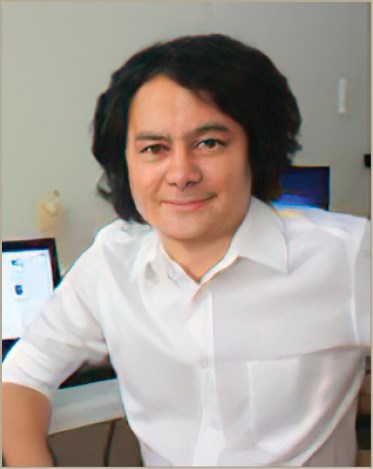26 Relevant Print Marketing Statistics: 2022 Ad Spending & Impact
Print marketing is not dead. Its impact on consumer brand recall and purchase decision is worth considering, especially if you want to implement an integrated, multi-channel approach to your marketing strategy. This article on marketing trends and predictions can provide more insights on strategies you can use for your business or marketing clients.
#brandbuilding
By Louie Andre
B2B and SaaS Market Analyst and Senior Writer
FinancesOnline

Is print marketing dead? Most people would think so, especially at a time when we are increasingly stuck to our digital devices. Marketers and brands are swaying in favor of digital advertising utilizing tools like content marketing software due to the increasing usage of smartphones and similar devices. This is evident in the decline of print ad spending, as we’ll later see in our print marketing statistics.

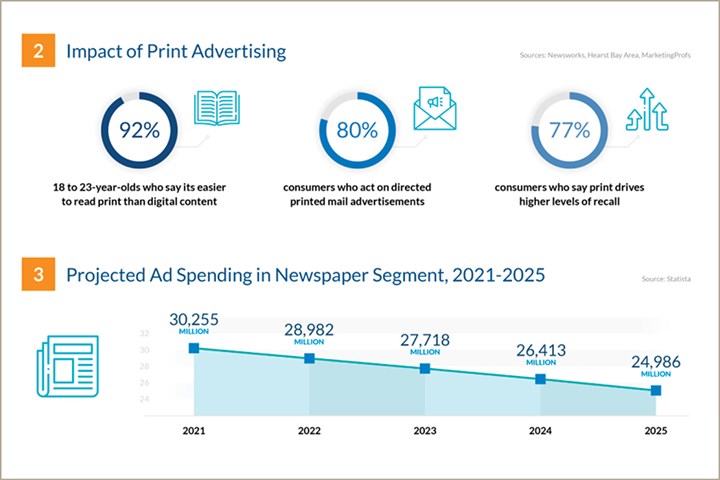
Based on digital vs print advertising statistics, print ads drive stronger brand recall.
However, you shouldn’t totally leave out print marketing from your marketing campaigns. That’s because based on digital vs print advertising statistics, print ads drive stronger brand recall. They are also more trusted by consumers when making purchase decisions. As such, in this article, we will discuss the key print marketing statistics of 2021. By understanding its benefits, how it compares with digital marketing, as well as the challenges that you might encounter should you choose to leverage it, you can make informed business decisions and boost your marketing efforts.
Print Marketing Statistics Table of Contents
- General Print Marketing Statistics
- Digital vs Print Advertising Statistics
- Benefits of Print Marketing Statistics
- Challenges of Print Marketing Statistics
1. General Print Marketing Statistics
It’s easy to assume that print marketing has lost its relevance in the digital era.
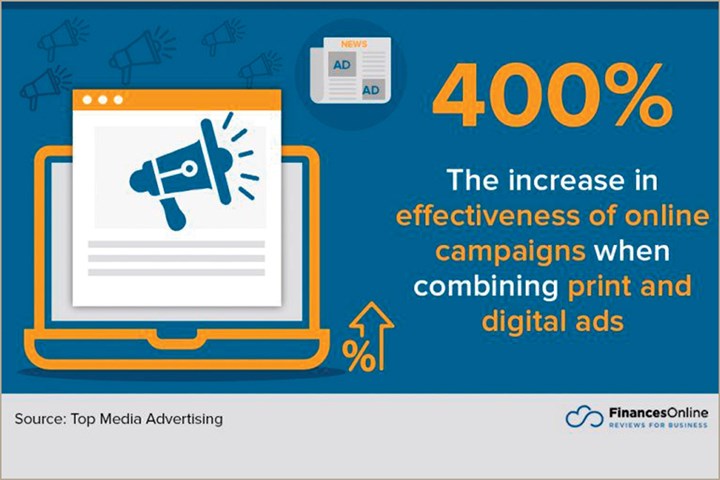
As more and more consumers are trading traditional print materials for smartphones, tablets, and laptops, businesses are also moving their advertisements online. However, here are a few statistics that might convince you that print ads are still important.
-
70% of households with an income above $100,000 are newspaper readers (Mansi Media, n.d.).
-
95% of people under 25 years old read magazines (Top Media Advertising, n.d.).
-
82% of consumers trust print ads the most when making a purchase decision (Burstein, 2017).
-
Print readers usually spend 20 minutes or more with their publication in hand, while a typical visitor to a digital news site sticks around for less than five minutes (Heitman, n.d.).
-
Print ads require 21% less cognitive effort to process (R.C. Brayshaw, 2020).
-
By combining print and digital ads, it will make online campaigns 400% more effective (Top Media Advertising, n.d.).
2. Digital vs Print Advertising Statistics
It’s easy for marketers to jump on the bandwagon and put all their money on digital marketing.
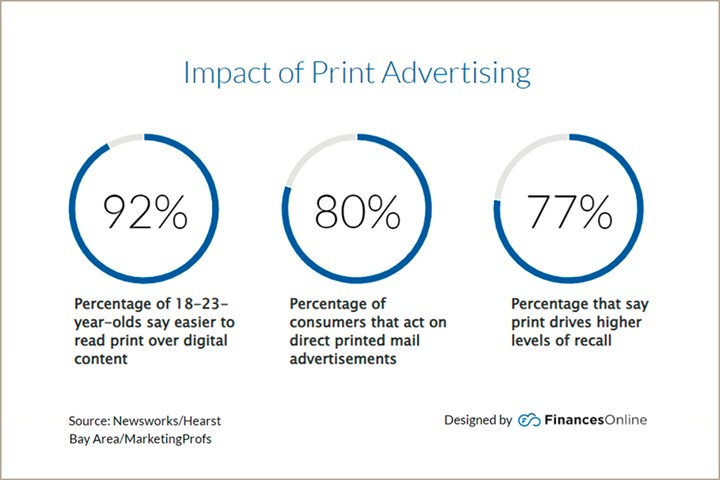
However, a closer look at these digital vs print advertising statistics will show us that print ads actually provide better results in terms of brand recall and response rate.
-
Nearly 80% of consumers act on direct printed mail advertisements compared to 45% of consumers who act on electronic advertisements (Potochny, 2017).
-
Print and direct mail marketing bring a 9% customer response rate compared to other digital marketing channels, which hover around 1% or less (R.C. Brayshaw, 2020).
-
Print ads generate a 20% higher motivation response—even more so if it appeals to more senses beyond touch (R.C. Brayshaw, 2020).
-
If you’re curious about brand marketing, you’ll be happy to know that advertising in print drives higher levels of brand recall vs. digital (77% vs. 46%) (Newsworks, 2020).
-
92% of 18- to 23-year-olds find it easier to read print over digital content (Forer, 2017).
-
The response rate for direct-mail marketing is 37% higher than the email rate (Medina, 2019).
-
Digital ads are less recalled than print ads but they are more effective than print ads at converting engaged readers into action takers (64% vs 55% for print) (Newsworks, 2020).
3. Benefits of Print Marketing Statistics
There are many benefits you can get from including print ads in your marketing strategy. For one thing, print is still a more effective medium if you want to build trust for your brand. It’s also a powerful driver of website visits since almost 30% of consumers who notice a print ad eventually visit the advertiser’s webpage.
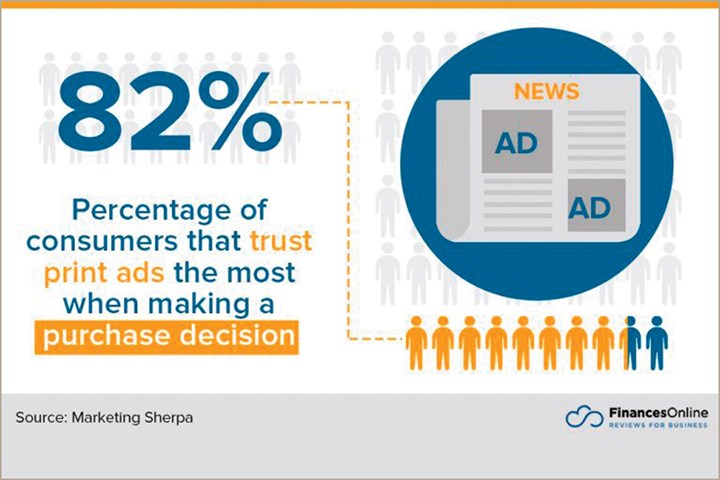
Moreover, newspaper ads can help you target a demographic of young adult readers. This may come as a surprise since many assume that the younger generation is all about going digital. Apparently, 58% of adults aged 18-34 read newspapers.
-
81% of monthly newspaper readers still read the print edition and 51% read print exclusively (Marketing Charts, 2017).
-
25% of print newspaper readers are under the age of 35 (Millennials and Gen Z) (Perri, 2019).
-
58% of adults aged 18 to 34 and more than 60% of adults aged 35 years and above read a newspaper (Mansi Media, n.d.).
-
All other measures have also increased among people who notice print ads. For starters, close attention to print ads has more than doubled since 2009/10, from 23% to 49% in 2020. Also, ad recall for print news brands has increased by an impressive 67% between 2009/10 and 2019/2020, and emotional reaction to print ads is now 37% in 2020 compared to 22% five years ago (Newsworks, 2020).
-
Consumers who see print ads also tend to visit the advertiser’s website—up 27% in 2020 from 12% in 2009, and purchase intent of consumers who notice print ads increased to 22% in 2020 from 7% in 2009 (Newsworks, 2020).
4. Challenges of Print Marketing Statistics
Print publishers around the world are feeling the crunch as ad spending on newspaper and magazines continues to drop. It’s undeniable that digital media has cut through traditional print and is slashing advertising revenue.
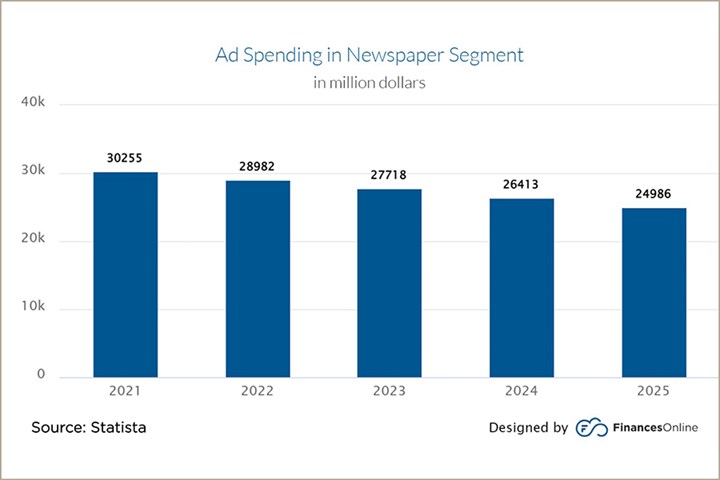
With newspaper circulation also reaching its all-time low compared to where it was two to three decades ago, it seems like the worst is yet to come for print publishers.
-
Ad spending in the Print Advertising segment is projected to reach $44,173 million in 2021. Spending is estimated to go down to $40,019 million in 2023 and $35,628 million in 2025 (Statista, n.d.).
-
Newspaper Advertising spending is projected to reach $30,255 million in 2021 and $24,986 million in 2025 (Statista, n.d.).
-
Magazine Advertising spending is projected to reach $13,918 million in 2021 and $10,642 in 2025 (Statista, n.d.)
-
Most global ad spending will be generated in the US in 2021 ($13,469 million). It’s followed by Japan ($4,779 million), Germany ($3,242 million), India ($2,713 million), and China ($2,037 million) (Statista, n.d.).
-
In 2020, US advertisers are estimated to spend more on digital advertising ($151.29 billion) than traditional advertising—print, TV, and radio ($107.13 billion) (Wagner, 2019).
-
Print advertising’s revenue is also declining. It’s projected to reach $5.5 billion in 2024, down from more than $25 billion in 2012 (Richter, 2019).
-
The circulation of weekday newspapers fell from nearly 63.3 million in 1984 to about 28.5 million papers in 2018. As for Sunday editions, circulation reached a height of 62.6 million in 1993 and fell to 30.8 million in 2018 (Feldman, 2019).
-
The US magazine industry is facing challenges as well. The estimated revenue of periodical publishers in the United States fell sharply in the past decade from $46 billion in 2007 to just over $26 billion in 2019 (Watson, 2021).
Print Marketing Is Not Dead
Going back to the question we posed at the beginning of this article, and after having gone through the print marketing statistics we presented, we can definitely say that print marketing is not dead. Though the industry is projected to experience a continued decline in ad spending and revenue, its impact on consumer brand recall and purchase decision are worth considering, especially if you want to implement an integrated, multi-channel approach to your marketing strategy. Our article on marketing trends and predictions can provide more insights on strategies you can use for your business or marketing clients.
References:
-
Burstein (2017). Marketing Chart: Which advertising channels consumers trust most and least when making purchases. Retrieved from Marketing Sherpa
-
Feldman (2019). Then & Now Newspaper Circulation. Retrieved from Statista
-
Forer (2017). Print: A Tangible Way to Invigorate Your Marketing Strategy [Infographic]. Retrieved from MarketingProfs
-
Heitman (n.d.). 5 Stats That Show the Effectiveness of Print Advertising. Retrieved from LocaliQ
-
Marketing Charts (2017). Half of Newspaper Readers Stick Exclusively to Print. Retrieved from Marketing Charts
-
Medina (2019). Print Still Matters in 2019. Retrieved from Relevance
-
Newsworks (2020). Print Vs. Digital Advertising. Retrieved from Newsworks
-
Perri (2019). 6 Tips for Using Print Advertising to Engage a New Audience. Retrieved from Hearst Bay Area
-
Potochny (2017). Print vs Digital: 4 Reasons Why Print Advertising Still Works. Retrieved from Hearst Bay Area
-
R.C. Brayshaw (2020). How Effective Is Print & Direct Mail Marketing? Retrieved from R.C. Brayshaw & Company
-
Richter (2019). The Dramatic Decline of Print Advertising. Retrieved from Statista
-
Statista (n.d). Print Advertising. Retrieved from Statista
-
Top Media Advertising (n.d.). Top Print Advertising Statistics and Effectiveness. Retrieved from Top Media Advertising
-
Wagner (2019). Digital Advertising in the US is Finally Bigger Than Print and Television. Retrieved from Vox
Need more information?
Louie Andre
B2B and SaaS Market Analyst and Senior Writer
FinancesOnline financesonline.com
About the Author
Louie Andre
Louie is a B2B and SaaS market analyst and senior writer for FinancesOnline. He is most interested in project management solutions, believing all businesses are a work in progress. From pitch deck to exit strategy, he is no stranger to project business hiccups and essentials. He has been involved in a few internet startups including a digital route planner for a triple A affiliate. His advice to vendors and users alike? "Think benefits, not features."
RELATED CONTENT
-
10 Truths About Marketing After the Pandemic
The Covid-19 pandemic upended a marketer’s playbook, challenging the existing rules about customer relationships and building brands. One year in, there’s no going back to the old normal. Here are 10 new marketing truths that reveal the confluence of strategies, operations, and technologies required to drive growth in a post-Covid-19 world.
-
3 Major Trends in Manufacturing (And They All Begin with “A”)
Peter Zelinski, Editor-in-Chief of Additive Manufacturing and Modern Machine Shop, sees 3 big, major, long-term trends that continue to reshape manufacturing.
-
Brand vs. Product Advertising. What’s the Fuss?
Marketers have long debated the merits of brand vs. product advertising. In truth, there are reasons for both. The strategy depends on the marketing situation.


